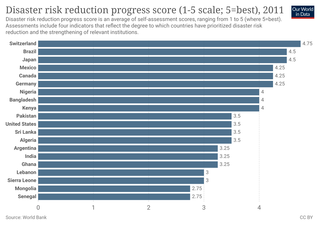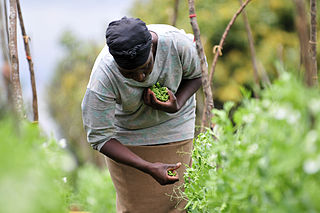
Risk management is the identification, evaluation, and prioritization of risks followed by coordinated and economical application of resources to minimize, monitor, and control the probability or impact of unfortunate events or to maximize the realization of opportunities.

A natural disaster is the highly harmful impact on a society or community following a natural hazard event. Examples of natural hazard events include floods, droughts, earthquakes, tropical cyclones, volcanic activity, wildfires. A natural disaster can cause loss of life or damage property, and typically leaves economic damage in its wake. The severity of the damage depends on the population's disaster preparedness and on the existing infrastructure. Scholars have been saying that the term natural disaster is unsuitable and should be abandoned. Instead, the simpler term disaster could be used, while also specifying the category of hazard. A disaster is a result of a natural or human-made hazard impacting a vulnerable community. It is the combination of the hazard along with exposure of a vulnerable society that results in a disaster.
The World Conference on Disaster Risk Reduction is a series of United Nations conferences focusing on disaster and climate risk management in the context of sustainable development. The World Conference has been convened three times, with each edition to date having been hosted by Japan: in Yokohama in 1994, in Hyogo in 2005 and in Sendai in 2015. As requested by the UN General Assembly, the United Nations Office for Disaster Risk Reduction (UNDRR) served as the coordinating body for the Second and Third UN World Conference on Disaster Reduction in 2005 and 2015.

Climate change adaptation is the process of adjusting to the effects of climate change. These can be both current or expected impacts. Adaptation aims to moderate or avoid harm for people, and is usually done alongside climate change mitigation. It also aims to exploit opportunities. Humans may also intervene to help adjustment for natural systems. There are many adaptation strategies or options. They can help manage impacts and risks to people and nature. The four types of adaptation actions are infrastructural, institutional, behavioural and nature-based options.

Disaster risk reduction (DRR) is an approach for planning and taking steps to make disasters less likely to happen, and less damaging when they do happen. DRR aims to make communities stronger and better prepared to handle disasters. When DRR is successful, it decreases the vulnerability of communities because it mitigates the effects of disasters. This means DRR can reduce the severity and number of risky events. Since climate change can increase climate hazards, DRR and climate change adaptation are often looked at together in development efforts.
Climate risk is the potential for problems for societies or ecosystems from the impacts of climate change. The assessment of climate risk is based on formal analysis of the consequences, likelihoods and responses to these impacts. Societal constraints can also shape adaptation options. There are different values and preferences around risk, resulting in differences of risk perception.
The Weather Info for All (WIFA) Initiative is a public-private partnership that works to reinforce the capacities and the capabilities of national meteorological services with the goal of supporting local communities worst impacted by climate change through the improvement of weather monitoring. "By bringing together the expertise and resources of different public and private actors, this project may help to save lives and improve the livelihoods of communities in Africa living on the frontlines of climate change." Kofi Annan, President of the Global Humanitarian Forum. The Forum, together with Ericsson, the World Meteorological Organization, National Meteorological Services (NMSs), the Earth Institute at Columbia University, as well as Zain and other mobile phone operators aim to deploy up to 5,000 automatic weather stations (AWSs) at wireless network sites across Africa, where less than 300 are reporting today.

Climate change is a critical issue in Bangladesh as the country is one of the most vulnerable to the effects of climate change. In the 2020 edition of Germanwatch's Climate Risk Index, it ranked seventh in the list of countries most affected by climate calamities during the period 1999–2018. Bangladesh's vulnerability to the effects of climate change is due to a combination of geographical factors, such as its flat, low-lying, and delta-exposed topography, and socio-economic factors, including its high population density, levels of poverty, and dependence on agriculture. The impacts and potential threats include sea level rise, temperature rise, food crises, droughts, floods, and cyclones.

The United Nations Office for Disaster Risk Reduction (UNDRR) was created in December 1999 to ensure the implementation of the International Strategy for Disaster Reduction.

The Climate and Development Knowledge Network (CDKN) works to enhance the quality of life for the poorest and most vulnerable to climate change. CDKN does this by combining research, advisory services and knowledge management in support of locally owned and managed policy processes. It works in partnership with decision-makers in the public, private and non-governmental sectors nationally, regionally and globally.

Globally, Nepal is ranked fourth in terms of vulnerability to climate change. Floods spread across the foothills of the Himalayas and bring landslides, leaving tens of thousands of houses and vast areas of farmland and roads destroyed. In the 2020 edition of Germanwatch's Climate Risk Index, it was judged to be the ninth hardest-hit nation by climate calamities during the period 1999 to 2018. Nepal is a least developed country, with 28.6 percent of the population living in multidimensional poverty. Analysis of trends from 1971 to 2014 by the Department of Hydrology and Meteorology (DHM) shows that the average annual maximum temperature has been increasing by 0.056 °C per year. Precipitation extremes are found to be increasing. A national-level survey on the perception-based survey on climate change reported that locals accurately perceived the shifts in temperature but their perceptions of precipitation change did not converge with the instrumental records. Data reveals that more than 80 percent of property loss due to disasters is attributable to climate hazards, particularly water-related events such as floods, landslides and glacial lake outburst floods (GLOFs).

Climate change affects men and women differently. Climate change and gender examines how men and women access and use resources that are impacted by climate change and how they experience the resulting impacts. It examines how gender roles and cultural norms influence the ability of men and women to respond to climate change, and how women's and men's roles can be better integrated into climate change adaptation and mitigation strategies. It also considers how climate change intersects with other socioeconomic challenges, such as poverty, access to resources, migration and cultural identity. Ultimately, the goal of this research is to ensure that climate change policies and initiatives are equitable, and that both women and men benefit from them. Climate change increases gender inequality, reduces women's ability to be financially independent, and has an overall negative impact on the social and political rights of women, especially in economies that are heavily based on agriculture. In many cases, gender inequality means that women are more vulnerable to the negative effects of climate change. This is due to gender roles, particularly in the developing world, which means that women are often dependent on the natural environment for subsistence and income. By further limiting women's already constrained access to physical, social, political, and fiscal resources, climate change often burdens women more than men and can magnify existing gender inequality.
Climate resilience is a concept to describe how well people or ecosystems are prepared to bounce back from certain climate hazard events. The formal definition of the term is the "capacity of social, economic and ecosystems to cope with a hazardous event or trend or disturbance". For example, climate resilience can be the ability to recover from climate-related shocks such as floods and droughts. Methods of coping include suitable responses to maintain relevant functions of societies and ecosystems. To increase climate resilience means one has to reduce the climate vulnerability of people and countries. Efforts to increase climate resilience include a range of social, economic, technological, and political strategies. They have to be implemented at all scales of society, from local community action all the way to global treaties.

The contributions of women in climate change have received increasing attention in the early 21st century. Feedback from women and the issues faced by women have been described as "imperative" by the United Nations and "critical" by the Population Reference Bureau. A report by the World Health Organization concluded that incorporating gender-based analysis would "provide more effective climate change mitigation and adaptation."
The Sendai Framework for Disaster Risk Reduction (2015–2030) is an international document that was adopted by the United Nations (UN) member states between 14 and 18 March 2015 at the World Conference on Disaster Risk Reduction held in Sendai, Japan, and endorsed by the UN General Assembly in June 2015. It is the successor agreement to the Hyogo Framework for Action (2005–2015), which had been the most encompassing international accord to date on disaster risk reduction.
Ecosystem-based adaptation encompasses a broad set of approaches to adapt to climate change. They all involve the management of ecosystems and their services to reduce the vulnerability of human communities to the impacts of climate change. The Convention on Biological Diversity (CBD) defines EBA as "the use of biodiversity and ecosystem services as part of an overall adaptation strategy to help people to adapt to the adverse effects of climate change".

Sustainable Development Goal 13 is to limit and adapt to human-caused climate change. It is one of 17 Sustainable Development Goals established by the United Nations General Assembly in 2015. The official mission statement of this goal is to "Take urgent action to combat climate change and its impacts". SDG 13 and SDG 7 on clean energy are closely related and complementary.

The United Nations Framework Convention on Climate Change (UNFCCC), the Paris Agreement, the Sustainable Development Goals (SDGs), and the United Nations Convention on the Rights of Persons with Disabilities (CRPD) are connected through their common goals of addressing global challenges and promoting sustainable development through policies and international cooperation.
Koko Warner is a climate change expert who specializes in human migration and displacement and who holds a PhD in economics from the University of Vienna. In 2014, the International Council for Science named Warner as one of the top 20 women making contributions to climate change debate.

Climate change adaptation in the Philippines is being incorporated into development plans and policies that specifically target national and local climate vulnerabilities. As a developing country and an archipelago, the Philippines is particularly vulnerable to a variety of climatic threats like intensifying tropical cyclones, drastic changes in rainfall patterns, rising sea levels, and rising temperatures. According to the UN Office for the Coordination of Humanitarian Affairs (OCHA), the Philippines is one of the most disaster-prone countries in the world. In 2021, the Global Climate Risk Index ranked the Philippines fourth of the ten countries most affected between the years 2000 and 2019. The need for managing climate risks through climate change adaptation has become increasingly evident. Adaptation can reduce, moderate or avoid current and expected climate effects or take advantage of beneficial climatic events. Developing greater resilience to various threats can be a major goal of comprehensive disaster risk reduction strategy. The Philippines is therefore working on a number of national and local adaptation and disaster risk reduction strategies to build the country's climate resilience.












